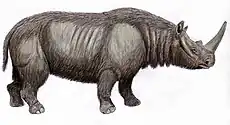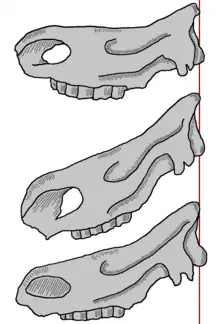| Narrow-nosed rhinoceros Temporal range: | |
|---|---|
 | |
| Skull of Stephanorhinus hemitoechus | |
 | |
| Stephanorhinus hemitoechus life restoration | |
| Scientific classification | |
| Domain: | Eukaryota |
| Kingdom: | Animalia |
| Phylum: | Chordata |
| Class: | Mammalia |
| Order: | Perissodactyla |
| Family: | Rhinocerotidae |
| Genus: | †Stephanorhinus |
| Species: | †S. hemitoechus |
| Binomial name | |
| †Stephanorhinus hemitoechus Falconer, 1859 | |
| Synonyms | |
| |
The narrow-nosed rhinoceros (Stephanorhinus hemitoechus), also known as the steppe rhinoceros is an extinct species of rhinoceros belonging to the genus Stephanorhinus that lived in western Eurasia, including Europe, as well as North Africa[1] during the Pleistocene. It first appeared in Europe some 600,000 years ago during the Middle Pleistocene and survived there until as recently as 40,000 years before present.
Description

The narrow-nosed rhinoceros was a large animal, reaching a shoulder height of as much as 2 m (6.6 ft).[2] It can be distinguished from other species of Stephanorhinus by its very long and low skull. Its nasals are relatively low, and its horn base poorly developed. Teeth are forward shifting.[3]
The narrow-nosed rhinoceros probably favored temperate open areas rich in low-growing vegetation. It displayed many similarities to its better known extinct relative, the woolly rhinoceros. It was probably not a pure grazer, but a mixed feeder, eating low-growing vegetation in open habitats, with its diet varying according to local conditions.[3][4][5][6]
In Apulia in southern Italy, remains of narrow-nosed rhinoceros from the middle Late Pleistocene were found to be smaller than those of other areas, indicating they may have been an insular form.[7]
Age and distribution
From the late Middle Pleistocene onwards, the narrow-nosed rhinoceros and its relative, Merck's rhinoceros (Stephanorhinus kirchbergensis) were the only surviving species of Stephanorhinus. In comparison to the widespread Merck's rhinoceros, the narrow-nosed rhinoceros had a more restricted distribution, including Europe,[8][9] as well as West Asia[10] and North Africa.[1] Remains found in Azerbaijan were previously referred to the species Rhinoceros binagadensis, while those in North Africa were referred to Rhinoceros subinermis.[11]
It had its widest distribution in Europe during interglacial periods where it would extend as far north as Great Britain, co-occurring alongside other large megafauna like the straight-tusked elephant (Palaeoloxodon antiquus), as well as the hippopotamus.[12]
In North Africa, remains of the narrow-nosed rhinoceros are known dating between 109-53,000 years ago.[1]
The narrow-nosed rhinoceros survived until around 40,000 years ago in southern Europe. The last records in Italy date to around 41,000 years ago,[6] while remains dating to 40,000 years ago are knowns from Bacho Kiro cave in Bulgaria.[13]
Human exploitation
Specimens of S. hemitoechus from the Middle Pleistocene (MIS 12, 478,000-424,000 years ago) Caune de l'Arago site in Southern France shows extensive evidence of butchery by archaic humans (presumably by Tautavel Man, which is found at the same site). The ratios of skeletal elements implies that only the parts of the body with the most meat were carried to the site. The profile of ages of rhino bones in the cave resembles natural mortality curves, suggesting that there was not selective hunting, and the fact that marks of other carnivores are rare implies that the carcasses were acquired by hunting or active scavenging.[14] A skull from Cueva Des-Cubierta in central Spain, dating to the early-mid Late Pleistocene (MIS 4-early MIS 3, ~71-43,000 years ago) exhibits fracturing and cut marks consistent with butchery likely by Neanderthals. The missing pieces of the skull were not found in the cave, suggesting that it had been butchered off-site. It has been proposed that the skull was kept as a hunting trophy along with the skulls of aurochs and bison.[15]
References
- 1 2 3 Faith, J. Tyler (2014). "Late Pleistocene and Holocene mammal extinctions on continental Africa". Earth-Science Reviews. 128: 105–121. Bibcode:2014ESRv..128..105F. doi:10.1016/j.earscirev.2013.10.009.
- ↑ "Narrow-nosed Rhinoceros(Stephanorhinus hemitoechus)". Gibraltar National Museum.
- 1 2 Fortelius, M.; Mazza, P.; Sala, B. (1993). "Stephanorhinus (Mammalia: Rhinocerotidae) of the Western European Pleistocene, with a revision of S. etruscus (Falconer, 1868)". Palaeontographia Italica, Pisa. 80: 63–155.
- ↑ Salari, L. (2019). "The Late Pleistocene faunal assemblage from Cava Muracci (Latium, Italy): Palaeoenvironmental implications for coastal central Italy during MIS 3". Comptes Rendus Palevol. 18 (1): 51–71. Bibcode:2019CRPal..18...51G. doi:10.1016/j.crpv.2018.04.006. S2CID 135071773.
- ↑ Rivals, Florent; Lister, Adrian M. (August 2016). "Dietary flexibility and niche partitioning of large herbivores through the Pleistocene of Britain". Quaternary Science Reviews. 146: 116–133. Bibcode:2016QSRv..146..116R. doi:10.1016/j.quascirev.2016.06.007.
- 1 2 Pandolfi, Luca; Boscato, Paolo; Crezzini, Jacopo; Gatta, Maurizio; Moroni, Adriana; Rolfo, Mario; Tagliacozzo, Antonio (2017-04-13). "LATE PLEISTOCENE LAST OCCURRENCES OF THE NARROW-NOSED RHINOCEROS STEPHANORHINUS HEMITOECHUS (MAMMALIA, PERISSODACTYLA) IN ITALY". Rivista Italiana di Paleontologia e Stratigrafia (Research in Paleontology and Stratigraphy). 123: N. 2 (2017). doi:10.13130/2039-4942/8300.
- ↑ Pandolfi, Luca; Petronio, Carmelo (2011). "The small-sized rhinoceroses from the Late Pleistocene of Apulia (southern Italy)". Rivista Italiana di Paleontologia e Stratigrafia. 117 (3): 509–520. doi:10.13130/2039-4942/5989.
- ↑ Pandolfi, Luca; Tagliacozzo, Antonio (1 March 2015). "Stephanorhinus hemitoechus (Mammalia, Rhinocerotidae) from the Late Pleistocene of Valle Radice (Sora, Central Italy) and re-evaluation of the morphometric variability of the species in Europe". Geobios. 48 (2): 169–191. doi:10.1016/j.geobios.2015.02.002. ISSN 0016-6995. Retrieved 13 January 2024 – via Elsevier Science Direct.
- ↑ Diana Pushkina: The Pleistocene easternmost distribution in Eurasia of the species associated with the Eemian Palaeoloxodon antiquus assemblage. Mammal Review, 2007. Volume 37 Issue 3, Pages 224 - 245
- ↑ Pokines, James T.; Lister, Adrian M.; Ames, Christopher J. H.; Nowell, April; Cordova, Carlos E. (March 2019). "Faunal remains from recent excavations at Shishan Marsh 1 (SM1), a Late Lower Paleolithic open-air site in the Azraq Basin, Jordan". Quaternary Research. 91 (2): 768–791. Bibcode:2019QuRes..91..768P. doi:10.1017/qua.2018.113. ISSN 0033-5894. S2CID 134216492.
- ↑ Giaourtsakis, Ioannis X. (2022), Vlachos, Evangelos (ed.), "The Fossil Record of Rhinocerotids (Mammalia: Perissodactyla: Rhinocerotidae) in Greece", Fossil Vertebrates of Greece Vol. 2, Cham: Springer International Publishing, pp. 409–500, doi:10.1007/978-3-030-68442-6_14, ISBN 978-3-030-68441-9, retrieved 2023-11-19
- ↑ Pushkina, Diana (July 2007). "The Pleistocene easternmost distribution in Eurasia of the species associated with the Eemian Palaeoloxodon antiquus assemblage". Mammal Review. 37 (3): 224–245. doi:10.1111/j.1365-2907.2007.00109.x. ISSN 0305-1838.
- ↑ Stuart, A.J., Lister, A.M., 2007. Patterns of Late Quaternary megafaunal extinctions in Europe and northern Asia. In: Kahlke, R.-D., Maul, L.C., Mazza, P. (Eds.), Late Neogene and Quaternary Biodiversity and Evolution: Regional Developments and Interregional Correlations Vol. II, Proceedings of the 18th International Senckenberg Conference (VI International Palaeontological Colloquium in Weimar). Courier Forschungsinstitut Senckenberg 259, pp. 287-297.
- ↑ Chen, Xi; Moigne, Anne-Marie (November 2018). "Rhinoceros ( Stephanorhinus hemitoechus ) exploitation in Level F at the Caune de l'Arago (Tautavel, Pyrénéés-Orientales, France) during MIS 12". International Journal of Osteoarchaeology. 28 (6): 669–680. doi:10.1002/oa.2682. S2CID 80923883.
- ↑ Baquedano, Enrique; Arsuaga, Juan L.; Pérez-González, Alfredo; Laplana, César; Márquez, Belén; Huguet, Rosa; Gómez-Soler, Sandra; Villaescusa, Lucía; Galindo-Pellicena, M. Ángeles; Rodríguez, Laura; García-González, Rebeca; Ortega, M.-Cruz; Martín-Perea, David M.; Ortega, Ana I.; Hernández-Vivanco, Lucía (March 2023). "A symbolic Neanderthal accumulation of large herbivore crania". Nature Human Behaviour. 7 (3): 342–352. doi:10.1038/s41562-022-01503-7. ISSN 2397-3374. PMC 10038806. PMID 36702939.